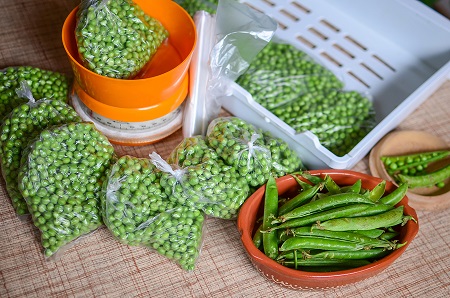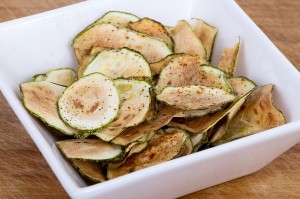Whether you’re cooking for one or a crowd, freezer cooking saves time and money. Plus, you’re less likely to eat junk if you have lots of healthy freezer meals prepared. So what are you waiting for?
Why Freezer Cooking?
Before the invention of electric refrigeration people preserved their food by other means. From the mid 19th century, iceboxes were used to keep food cool—an insulated box cooled by blocks of ice delivered daily by the ice man.
The spring house was common in rural areas: a one-room building constructed over a spring to maintain a constant cool temperature for dairy, meat, and other perishables.

When the electric refrigerator and freezer were invented, preparing in bulk and long-term food storage became much easier. And while “freezer meal” has come to be synonymous with prepackaged processed food full of chemicals, freezer cooking can actually be something cost-effective, simple, and healthy.
Today, there’s no reason NOT to cook for your freezer. Here are just a few of the benefits:
- Great way to cook for a big family or one or two people—easy to customize to your needs.
- Saves time on cooking during the month
- Saves money by buying in bulk and using seasonal ingredients.
Yes, you can do this. Even if you…
- Don’t have a lot of freezer space.
- Don’t like traditionally “frozen” foods like casseroles. You’d be surprised at all the things that freeze really well!
- Have a limited food budget. Actually, freezer cooking is more economical.
- Don’t like to cook. You can keep your meals very simple, with dump-and-go options for your slow cooker, and more.
What Happens to Nutrients When You Freeze?
Frozen food loses its nutrients very slowly over time, so freezing is a very good option to preserve the nutritional value of food.
The method of cooking is also important here. Baking, blanching, steaming, are all healthy ways of preparing food that lend well to freezing. You can also prepare all the ingredients in sealable bags, uncooked, with the sauce in a separate bag, so that all you have to do is defrost, cook, and enjoy (or throw in a slow cooker for an even easier meal!)
Want to Get Started? Here’s What You’ll Need:
- Appliance for cooking and reheating.
- Storage containers (preferably glass) in various sizes, or sealable freezer storage bags
- A permanent marker for labeling OR printable labels
- Freezer space: plan your meals around how much you are able to store at a time
- Optional: crock pot, food processor
There are a few ways to do freezer cooking. Some people prefer to have one big cooking day per month. Others will make double batches of all their meals to store in the freezer for later. Choose whatever works best for you and your family. To help with portion control, you may wish to store the prepared foods in batches to fit single servings for each meal.
Some Recipes for Inspiration:
- Bran Muffins Perfection!
- Butternut Squash Muffins
- Lemon Cottage Cheese Muffins
- Creamy Sweet Potato Carrot Soup
- Red Kidney Bean Chili
- Yeast Free Pizza Crust
- Spicy Cashew Chicken Stir Fry
- Moroccan Lamb Stew with Spiced Roasted Vegetables
- Chicken Barley Casserole
- Pumpkin Bread
and more…





I am also new and getting a little over whelmed, but I am also getting very excited. I am going to start this Monday.
I guess my biggest challenges are how to prepare the foods and the portion sizes(do I need to buy a scale?).
I wood like to cook a week’s menu at a time.
I watched the exercise video today and it is doable.
Hi, Navagator, and welcome! You don’t necessarily need to buy a scale, as estimates can be made from volume measurements. For example, liquids and liquid-like substances (such as yogurts, sauces) are 2 tablespoons for each ounce, flours and shredded/grated/ground items are 1/4 cup for each ounce, and solid protein foods are about the size of the palm of your hand (without fingers) for each 4 ounces.
I am trying to do at least one weeks menus but am confused about the meats for lunch, can I use supermarket deli meats. I don’t like cooking at lunchtime
And we eat out often for dinner as we are both retired and in our eighties.
Do I have to write out my weeks menu or is there a form to put them on.
Hi, Ann. The Menu Planner arranges your menu for you – just select the foods you want, and the application will do the rest.
We don’t encourage “deli meats” if they’re processed – it’s better to just slice fresh cooked meat and freeze portions for later use, so that you don’t have to cook at lunch time.
As far as dining out goes, you can use your menu here as a guide for food portions, then make healthy choices at the restaurant. The following are a few tips:
• If you can, get online to search for the ideal place ahead of time, filtering the options by features. Look for restaurants with an emphasis on whole foods, including vegetables and even ‘slow’ cooking – or at least a de-emphasis on junk food, deep-fat frying, heavy sauces, and rich sweets.
• If you know in advance where you’re going, peruse the menu ahead of time and prepare yourself with the right choices. The usual wisdom applies here: salads, cooked or ‘hidden’ vegetables (i.e. red sauce and salsa), baked or sautéed entrees, light sauces, and fruit for dessert. Or if nothing else, “prepared how you like it”.
• Avoid the bread or chip basket, or any other ‘empty calorie’ filler that a restaurant may offer before a meal. This will add a whole new course that you hadn’t anticipated, usually made up of refined carbohydrates an undesirable oils. This can be diet sabotage, so kindly ask the server in advance to leave the breadbasket or chips and salsa off your table, so you are not tempted. If you order unsweetened tea or water with lemon in advance for sipping, you may not miss it. When it comes to the real food, eat bulky, low energy-density (a.k.a. ‘low-calorie’) foods first, generally high in water and fiber – order a salad or clear soup as your first course, and when dinner arrives, start with the lightest foods on your plate, usually the vegetables.
• Don’t be shy about asking how your food is prepared. They are there to serve customers, of which you are one. Even if your server doesn’t know, the cook does, and if you do, you can take it or leave it – or improve it. Find out if butter, margarine, or oil is used, and what is available for substitution. Ask about the sauce that comes with an entrée, and if it has “cream”, “butter”, or “cheese” at the core – then go with a healthier alternative.
• Look for foods on the menu that are broiled or grilled (but not charred or blackened), poached, steamed, roasted, or baked; avoid foods that are fried, crispy, creamy, creamed, au gratin, escalloped, or breaded – all of which are synonyms for high amounts of added fat prepared in an unhealthy way.
• Balance is key. If you really want a high-calorie item, balance it out with lighter choices for the rest of the meal.
• Every food has a healthier version. Order the leaner type or cut of meat, and exercise portion control (take advantage of the doggie bag, and only eat half if the portion is too large). If you love fish and chips, then try grilled fish and oven-fried potatoes, etc. Substitutions can usually be made. Here are some healthy choices you can make at different types of restaurants:
– At a pizzeria, choose a plain cheese pizza (not ‘extra’ cheese) with a plain crust (not ‘stuffed’), or pizza with vegetable toppings instead of meat toppings, such as ‘Margarita’ with fresh tomatoes.
– In an Italian restaurant, if you like chicken, veal, or eggplant parmesan, try grilled chicken or eggplant with marinara sauce and a sprinkle of parmesan cheese. Ask for oil and vinegar on the side to dress your own salad. Order pasta with red sauce such as marinara, instead of such creamy white or butter sauces as Alfredo. Mushrooms make a great low-fat meat alternative. Have sorbet or a cappuccino for dessert instead of rich cake – unless you’re splitting it 4 or more ways.
– In an Asian restaurant, choose steamed rice instead of fried rice – brown if you can get it! – steamed dumplings or vegetables instead of fried egg rolls or tempura, as well as vegetarian entrees that include a number of different vegetables instead of meat; particularly avoid deep-fried entrees such as lemon chicken and ‘sweet-and-sour’ pork or chicken. Be sure to avoid monosodium glutamate (MSG), which can work against your weight and health goals, and opt for low-sodium soy sauce. Have a salad or clear/miso soup as a first course.
– In a Mexican restaurant, choose salsa instead of sour cream or cheese dips; avocado is a great source of ‘good’ fat, but it is still quite dense, so go easy on it. Choose dishes made with plain, soft tortillas that aren’t fried, such as burritos, soft tacos and enchiladas. Have baked instead of refried beans.
– In a cafeteria or food-buffet restaurant, fill your plate with plain vegetable side dishes before you go for the heavier items. Look for grilled, broiled or flame-cooked chicken, fish, and lean meats or tofu, and avoid anything breaded, batter-dipped or fried. If there’s a salad bar, concentrate on crisp, crunchy vegetable and bean mixtures; leave the potato, macaroni and tuna salads behind. Avoid going back for seconds on all items except vegetables, and be sure to use dressings sparingly unless naturally light, such as lemon juice and/or vinegar.
• If you want a salad with dressing on the side, ask for it. If the house dressing is too rich, oil and vinegar are almost always available, at least upon request. Vegetables can always been steamed instead of fried, and lemon and spices added instead of butter. If you want your chicken grilled instead of fried or smothered, go for it. The same goes for marinara sauce instead of the regular cream-based sauce. You get the idea.
• Stick with sound serving sizes, though sometimes this is easier said than done. Many restaurants, especially the ‘affordable’ ones, make it a point to fill your plate to give you a sense of value. Though this seems like a good idea, be aware that it can take up nearly your entire daily allotment for fat and/or energy. Cut your ‘gains’ right away, and divide your restaurant portion into two – share with a dining partner, or just eat half there and pack the other half to go – in this way, you avoid the problem of eating too much and paying for it later. If you know you’ll be tempted to eat more than you should, ask to have your ‘doggy bag’ prepared in advance, so you’ll only get a sensible portion size at the table. Some restaurants will even let you buy a half order or children’s portion of an entrée.
Hi I’m new here and I have very little free time, so even though it’s days since I signed up this is the first time I get few minutes to read and try to figure this out. How can I know that a recipe is ok to be freezer cooked? I know that my only chance to follow this is to prep my food preferable – weeks ahead, how I’l make that fit my week food plan I still have to figure out.
Hi, Sissy. Some of our recipes have “freezer-friendly” somewhere on their respective pge, but for those that don’t, you can use the list below to tell if a food won’t survive freezing.
FOODS THAT DO NOT FREEZE WELL
Raw vegetables (will become limp, water-logged, may develop off colors and flavors)
Soy milk (will curdle and separate to become watery and lumpy)
Tofu (will become gritty)
Soft dairy usually refrigerated, such as yogurt, cottage cheese, ricotta cheese, cream cheese, sour cream (will curdle and separate to become watery and lumpy)
Cooked rice or pasta (mushy when reheated)
Raw eggs and cooked egg whites (especially in salads, creamed foods, sauces, and desserts such as meringues and icings – will become soft, tough, rubbery, spongy)
Cream or custard fillings (will curdle and separate to become watery and lumpy)
Cheese or crumb toppings on casseroles (will become soggy)
Mayonnaise or salad dressing (separates)
Gelatin in salads or desserts (weeps)
Prepared sandwiches (may make bread soggy)
Fried foods except French fried potatoes and onion rings (will lose crispness and become soggy)
I just joined a couple of hours ago and I’m reading and it’s a lot to take in. I’m a bit overwhelmed by it all. I’m probably going to pick and choose from the menu that I have for the first week if I don’t follow these menus verywell, past experience!. But I’m going to try, here’s to the Future
Hi, Peg, and welcome! We are happy to help in whatever way we can.
Hi I only joined last night, It all seems a bit much to take in, so I’m ploughing through it lol can you use frozen foods? ie: chicken veg I eat a lot of chicken so my monthly shop is done around my freezer
Thanks Dee
Hi, Dee, and welcome! Frozen foods are fine, as long as they are not overly processed (like most TV dinners and “convenience” foods).
I’m still getting started. Lots to do to get ready. Haven’t actually made my menus. Struggling. Trying to figure out what I need to get and do. It DOES seem like TOO much food. I’m not used to eating so much. Working on it.
Yes I am trying to get started as well. Too many containers and stuff to bring to work. I’m not alone!!!
I think what I read these things are wonderful. It help me… I thank you!!!
Hi, Sandra. “SWG” stands for “sprouted whole grain”. You can read more about it here: https://www.trimdownclub.com/what-is-SWG-bread.
Hi Deborah-I just joined today. Can you tell me what SWG bread is?
When I had 4 surgeries the last 10 months , I finally came up with a list that allowed me to stay on the plan while I was recovering… It is also something that will help all of us who lead VERY BUSY lives.. I hope it helps someone…
emergency freezer food!!! Things to fix ahead of time for surgeries or busy seasons!
Freezer Foods for surgeries and other busy seasons of life.
1. SWG bread. I made four loaves in the bread machine, because that is one thing I don’t want to run out of.
2. Chili -Make a big batch , and put it in three containers.
3. Vegetable soup-Make a big batch and put it in three containers.
4. Homemade chicken Noodle soup with gluten free noodles.-3 containers
5. Grill a big batch of chicken breasts and thighs on the grill and use your vac-n-seal (if you have one) to put them into meal sized portions.
6. Grill 24 hamburger patties and divide into meal-time portions.
7.Make your Mexican and Italian meat recipes in the forum and make enough to fill 5 or 6 baggies of each one.
This makes it so simple for your husband to just boil some noodles or heat some SWG corn tortillas and your meat is then ready. So good for spaghetti or tacos ,or taco salad, To throw some into your soups for a meat entrée
8. Rostisserie chicken deboned or bake a smoked turkey and debone the meat off of it. Place 3 ounces in some bags , 3 oz bags and 4oz bags. Then put all the little bags in a big baggie. to use to make chicken salad. or chicken sandwiches, Don’t put all the meat in one bag because then you have to thaw it several times to use it all. Not safe!!!! You can then put come of the bagged chicken in a larger bag and put a package of Swg tortillas to make a fajita kit. Cook your bell peppers and onions and you are there in a matter of minutes.
9. As you are cooking meals now make more than enough and put the reserve in the freezer LABELED!!!!!!
10. Make a double batch of meatloaf. Put it in two pans.
11. Cook a large pot of green beans in the crockpot(recipe in the forum) Sack up mealtime servings and freeze.
12. Cook a crockpot of pinto beans with one of those smoked turkey legs. D up into serving sized baggies. Divide
13. Make a batch double batch of muffins and put them in a huge bag just to be able to pop out a couple for breakfast.
14. Batch a couple loaves of swg pumpkin bread. slice into serving size pieces. Wrap each piece individually in foil
and place in and label a large bag to make it easy to find.
15. Buy frozen blueberries, blackberries, strawberries to be able to put in swg cereal. Or to make smoothies
16. Be sure you have your favorite nut butter.
17. Buy 3 bags of Skinnypop . That should last a long time but makes an easy snack with cheese sticks and V-8.
18. Buy a case of v-8 at Sam’s at Costco. It is a great substitute for a veggie when you just can’t eat any more. It’s great over ice.!!
19. Make sure you have plenty of cheese string cheese or block cheese. You can vac-n-seal or freeze .
Have plenty of boxes of whole grain crackers on hand for snacks.
20. Make a list of the fresh veggies and fruit you want when you get out of the hospital. Put it on the fridge if you are going to rehab. The day before you go home then they can go to the grocery store and stock up. Trust me pain meds will make you make out one strange list!
21. Buy a couple bags of baked chips and pretzels. 20 is a serving.
22. One really good snack is whole grain crackers with melted cheese and a piece of fruit.
23. Cook the pork -apple onion crockpot recipe in the forum and divide into three meals.
If I think of any others I’ll add it later. This should be enough to keep you busy for at least a couple days!! Hehe
24. Make up a couple of batches of Biggest Loser pancakes, and 3/4 c pumpkin to each batch. Each pancake count 1 protein and 1 carb. !! Put them in a couple of freezer baggies and then you can get a couple out and put them in the toaster. Add cut up strawberries or blueberries. Yummy
Where do I get the recipe for the biggest loser pancakes
Hi, dmste1. Here you go: https://www.trimdownclub.com/recipe/oatmeal-pancakes-2.
YOu will absolutely love it!!! Not only do you save money on cheeses and meats… you can use the jar attachment and seal to
get those nuts out of the freezer to make room for all your yummy food to prepare ahead of time. If you toast the nuts before you vac-n-seal then it keeps them from molding and they are then toasted and ready for your recipes or for snacking. You can also reseal if you just want a few. It is the best spent money ever!! 😛
I too am going to purchase a foodsaver. Great idea to freeze in a container before hand. The ready made bags are larger than an individule serving. Thanks for the idea.
I love taking a day to prepare and freeze meals. I recently purchased a FoodSaver that has helped immensely in preventing frozen food from freezer burn. One example I really love is I have a couple of soup recipes that I freeze in 6 oz plastic containers. Once frozen I then vacuum seal them individually with my FoodSaver. When I am feeling hungry I can then take one out of the freezer, heat and serve.